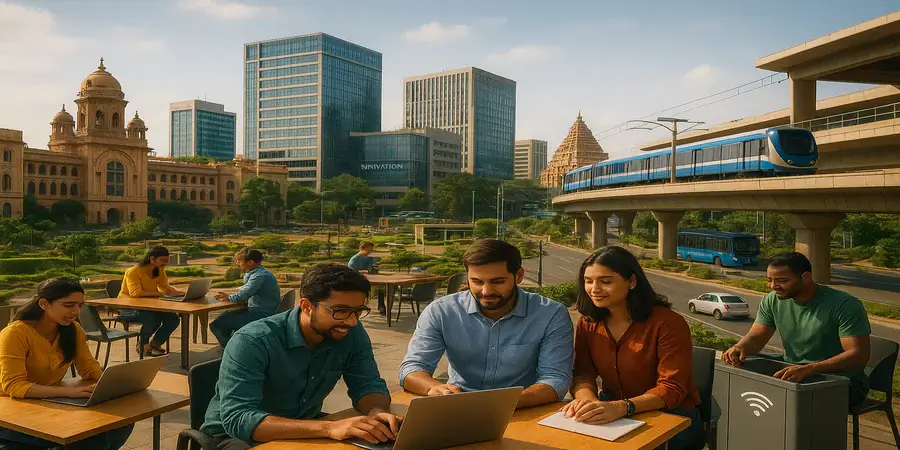The narrative of Indian entrepreneurship is undergoing a dramatic rewrite, one that extends far beyond the gleaming towers of Bangalore and the venture capital corridors of Mumbai. In a transformation that would have seemed unimaginable just a decade ago, India’s Tier 2 and Tier 3 cities now house an astounding 49% of the nation’s 56,000 startups, fundamentally reshaping the geography of innovation and challenging long-held assumptions about where transformative businesses can emerge and thrive.
This seismic shift represents more than statistical curiosity it signals the democratization of entrepreneurship across the world’s most populous nation, unlocking unprecedented economic potential in cities that were previously considered peripheral to the innovation ecosystem. From Tenkasi in Tamil Nadu to Kanpur in Uttar Pradesh, a new generation of entrepreneurs is proving that proximity to traditional tech hubs is no longer a prerequisite for building scalable, globally competitive businesses.
The Great Startup Migration: Beyond Metropolitan Boundaries
The numbers tell a compelling story of entrepreneurial dispersion. Of India’s 56,000 registered startups, approximately 27,440 are now based outside major metropolitan centers, with 45% of these ventures receiving formal recognition from the Department for Promotion of Industry and Internal Trade (DPIIT). This geographic redistribution represents a fundamental shift in the Indian startup ecosystem, driven by a confluence of technological enablers, economic incentives, and demographic movements that have collectively redefined the possibilities for entrepreneurial success.
The COVID-19 pandemic accelerated what was already an emerging trend, as remote work capabilities demonstrated that world-class products could be built from anywhere with reliable internet connectivity. The subsequent reverse migration of talent from metros to smaller cities created an unexpected catalyst, bringing Silicon Valley-trained engineers and seasoned executives back to their hometowns, armed with global experience and local insights.
“We realized that innovation doesn’t require a Bangalore address,” explains Ravi Kumar, founder of AgriTech startup FarmSync, which operates from Nashik in Maharashtra. “What it requires is deep understanding of real problems and the tenacity to solve them. Here, we’re closer to our customers, our costs are manageable, and our team is motivated by the opportunity to transform their own communities.”
Digital Infrastructure as the Great Equalizer
The transformation of India’s smaller cities into viable startup hubs is inextricably linked to the nation’s ambitious digital infrastructure initiatives. The BharatNet program, which aims to provide high-speed broadband connectivity to 250,000 gram panchayats, has been instrumental in creating the technological foundation necessary for knowledge-based businesses to flourish in previously underconnected regions.
Digital India’s comprehensive approach encompassing everything from Aadhaar-enabled digital identity systems to UPI payment infrastructure has effectively eliminated many of the traditional barriers that once made operating from smaller cities challenging. Today, a fintech startup in Indore can access the same digital payment rails as one in Gurgaon, while an e-commerce venture in Coimbatore can leverage identical logistics networks and digital marketing platforms.
This digital democratization has been particularly transformative for startups serving India’s vast rural and semi-urban markets. Companies based in Tier 2 and Tier 3 cities often demonstrate superior understanding of local market dynamics, consumer behaviors, and cultural nuances that prove crucial for building products with mass market appeal.
The Economics of Innovation: Cost Advantages That Matter
The economic fundamentals supporting this geographic shift are compelling and sustainable. Commercial real estate costs in Tier 2 cities typically range from ₹30-50 per square foot compared to ₹100-150 in metropolitan areas a differential that can dramatically impact a startup’s burn rate and runway extension capabilities. For early-stage ventures operating with limited capital, these savings can mean the difference between survival and shutdown.
Salary arbitrage presents equally significant advantages. While a software engineer in Bangalore might command ₹12-15 lakhs annually, comparable talent in cities like Pune, Ahmedabad, or Kochi often accepts ₹6-8 lakhs, not necessarily due to lower capability but because of reduced living costs and lifestyle preferences. This arbitrage enables startups to build larger teams with the same capital, accelerating product development and market entry timelines.
“Our engineering costs are roughly 40% lower than what we’d pay in Bangalore, but the quality of work is identical,” notes Priya Sharma, CTO of EdTech startup LearnLocal, based in Jaipur. “More importantly, our team stability is higher because people aren’t constantly being poached by competitors, and they’re genuinely invested in building something meaningful in their home city.”
Success Stories: Proving the Tier 2 Advantage
The most convincing evidence of this geographic transformation lies in the success stories emerging from India’s smaller cities. Zoho Corporation’s strategic decision to establish major operations in Tenkasi, Tamil Nadu a town of 200,000 people represents perhaps the most visible validation of the Tier 2 city model. Sridhar Vembu, Zoho’s founder, deliberately chose to build the company’s R&D center away from traditional tech hubs, creating high-quality employment opportunities while maintaining lower operational costs.
CarDekho’s journey to unicorn status from Jaipur demonstrates that automotive technology ventures can achieve global scale without Silicon Valley zip codes. The company’s deep understanding of India’s complex automotive market, combined with Rajasthan’s business-friendly policies and cost advantages, enabled rapid expansion across multiple verticals including insurance, financing, and marketplace services.
Meesho’s remarkable penetration into India’s social commerce market exemplifies how Tier 2 city startups can build products specifically designed for the next billion users. Based in Bangalore but with significant operations in smaller cities, Meesho’s platform enables millions of small entrepreneurs primarily women in smaller towns to build businesses through social media channels, creating economic opportunities that traditional commerce platforms couldn’t address.
Government Support and Policy Innovation
State governments across India have recognized the economic potential of startup ecosystems and are actively competing to attract entrepreneurs through targeted incentive programs. Uttar Pradesh’s startup policy offers ₹1 crore in funding support and 100% stamp duty exemption, while Gujarat’s iNDEXTb incubation program provides comprehensive support including mentorship, market access, and funding facilitation.
The Startup India initiative has been particularly effective in smaller cities, where government support often carries greater relative impact due to limited private sector infrastructure. Incubation centers, co-working spaces, and accelerator programs supported by state governments have created entrepreneurial ecosystems in cities that previously lacked such infrastructure.
“The government support we received in Bhubaneswar was instrumental in our early growth,” explains Amit Patel, founder of HealthTech startup MedAssist. “Beyond financial incentives, the willingness of local officials to understand and adapt policies for startup needs made a significant difference in our ability to scale operations.”
Infrastructure Evolution and Ecosystem Development
The startup boom in smaller cities has catalyzed broader infrastructure development, creating positive feedback loops that attract additional businesses and talent. Co-working spaces, startup cafes, and innovation hubs have emerged organically in response to entrepreneurial density, while educational institutions are adapting curricula to support the growing demand for startup-relevant skills.
Internet connectivity improvements have been particularly dramatic, with 4G coverage now extending to over 95% of India’s geography. The upcoming 5G rollout promises to further level the playing field, enabling bandwidth-intensive applications like augmented reality, IoT solutions, and real-time data analytics to operate effectively from any location.
Financial services infrastructure has evolved similarly, with digital banking, automated accounting systems, and online compliance platforms eliminating many of the operational complexities that once made smaller cities challenging for business operations.
Talent Dynamics and Human Capital
The reverse migration of experienced professionals to their hometowns has created unexpected talent clusters in cities that previously struggled to attract skilled workers. IIT and IIM graduates who might once have remained permanently in metros are increasingly choosing to return home, often as startup founders or early employees, bringing world-class experience to local ecosystems.
This talent influx has been complemented by local educational institution improvements, with engineering colleges and management schools in Tier 2 cities upgrading their programs to meet startup ecosystem demands. Industry-academia partnerships have become more common, creating internship programs and placement opportunities that retain local talent while building startup-relevant capabilities.
Global Market Access and Export Potential
Technology has eliminated geographic constraints on market access, enabling startups in smaller cities to serve global customers from day one. Software-as-a-Service (SaaS) companies in Tier 2 cities are building products for international markets, while e-commerce platforms are facilitating exports of local products to global consumers.
The cost advantages of smaller cities become particularly compelling when building products for price-sensitive global markets. Indian startups can offer competitive pricing while maintaining healthy margins, creating sustainable advantages in international competition.
Future Trajectory: The 2035 Vision
Current trends suggest that by 2035, Tier 2 and Tier 3 cities could capture 50% of India’s startup ecosystem, potentially housing over 100,000 ventures and creating approximately 50 million direct and indirect jobs. This projection is supported by continued infrastructure development, expanding educational capacity, and evolving investor attitudes toward geographic diversification.
The economic implications extend far beyond job creation. This startup distribution could generate ₹15-20 lakh crores in economic value while reducing regional inequality and creating more balanced national development patterns.
For global investors and emerging market strategists, India’s Tier 2 and Tier 3 startup revolution represents an unprecedented opportunity to access innovative companies at attractive valuations while supporting inclusive economic growth. The next decade will likely see increasing international investor attention toward these markets, as the success stories multiply and the infrastructure advantages become more apparent.
The transformation is no longer a future possibility it’s today’s reality, reshaping how the world’s largest democracy builds its innovation economy from the ground up.







